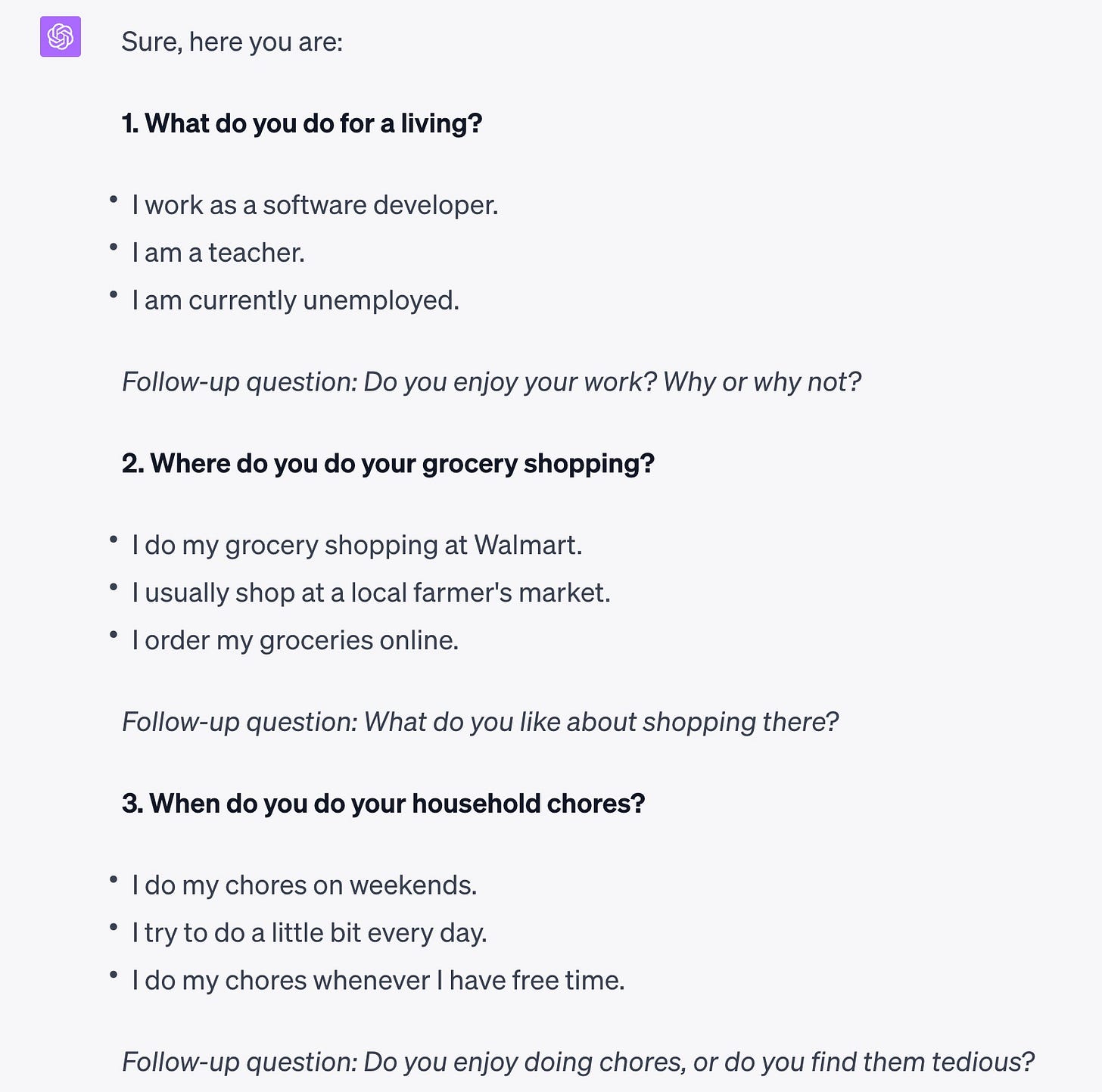The Art of Prompting Artificial Intelligence for ESL Teachers
A case study focusing on conversational questions for one-on-one teaching or pair work in classroom settings
Note: prompts for the exercises below can be found in the paid subscriber section.
This post summarizes some of the things I've observed after working with AI for a year (in OpenAI's playground before ChatGPT came along).
The first step in prompting AI: you need to develop a clear vision of your intended creation. You may start with a general idea, but you will have to tweak and fine-tune it as possibilities and obstacles emerge. As you fine-tune your vision, you will also fine-tune your prompt. Over time, it’s likely to become more and more complex as you edit it and inevitably make it more intricate. It’s a really good idea to keep a record of your prompts. I now have hundreds as I strive to do more and more things and explore new ideas. I’ve found managing my “prompt history/archive” to be quite a challenge.
There's a lot of hype about prompt generators, but they usually excel at generalities, not specifics. If you are in a specific field, such as teaching English as a second language, they will only take you so far. Artificial Intelligence, at the moment, is intelligent, but not creative. From my experience, they are creative only in the sense that they can juxtapose different kinds of things (e.g., exercises) together very quickly, giving the appearance of creativity. However, in doing this, they can inspire new ideas and open the door to endless possibilities. As a teacher, you then need to develop a clear vision of your idea. Once you have this vision, you can create a prompt to bring it to reality. Over time, you will probably realize you can apply this prompt to many different topics or aspects of grammar. Moreover, the prompt can scale up or down (levels of difficulty) and out (to different content areas) simply by editing the prompt. One thing I have discovered is that every topic or piece of content has its own idiosyncrasies, so the “basic“ or “core” prompt has to be tweaked for each specific use. This is where teaching knowledge and experience aid you in creating good prompts that prompt generators can’t emulate.
I want to provide an example of the development of a prompt through a case study—a real-world example! While I usually teach classes ranging from 30 to 60 students, I also instruct an adult student "one-on-one" online. He needs to practice speaking and has some background in English, but struggles with recalling the language and finding vocabulary to answer questions. It's like he has to re-familiarize himself with words he once learned. It was a bit slow and difficult to get him to answer questions. So, I created a system where I had a set of questions with multiple possible responses for him to choose from. I also realized I could add follow-up questions. The problem for me as a teacher was that I wanted to target new specific topics and aspects of grammar in each class, 3 times a week. I needed new, student-friendly sets of easy-to-answer questions about new topics for each class. This is where AI came in. I created and developed a core prompt to solve this problem. The prompt generally creates 10 “wh” questions and 5 “yes/no” questions with 3 possible responses to each question and a follow-up question if we want to expand the conversation. This makes it easier for the learner, as they can choose an answer if they can’t think of their own. Now that I have created and tested the prompt, I can quickly produce sets of conversational questions for any teaching situation. I just tinker with the core prompt to suit my purpose. I also have gradually been adding instructions to improve formatting and to make the questions more conversational.
Below are some examples in PDF format that can be downloaded. Here is a screenshot of ChatGPT’s output from the conversational prompt. Note: to retain the formatting from ChatGPT4, you have to drag across the text to select all.
Above are examples of sets of grammar focused conversational questions. I soon realized that I could expand into sets of discussion questions around specific topics. Just as a random example, after listening to a radio program about working from home, I decided to create sets of conversational questions about this topic. The first set of questions is for adult students who have a job.
These questions are fine for pre-intermediate adult working students. But the set below might be better for weaker students.
And as I also teach students at university. I might need a set of questions for them.
And here is another exercise for practicing the present simple while talking about online activities.



